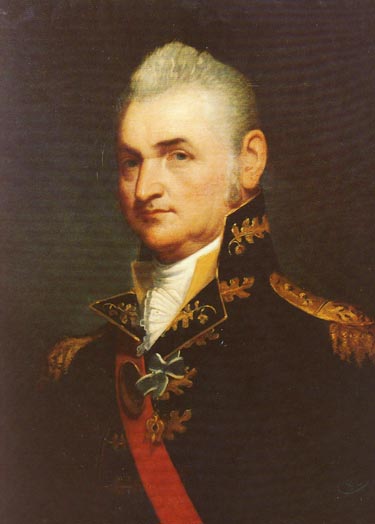By Walter M. Brackett
Oil on canvas, 29
Henry Dearborn was born in Hampton, New Hampshire, on 23 February 1751; studied medicine under Dr. Hall Jackson at Portsmouth; married Mary Bartlett, 1771; entered practice as a physician in 1772; was elected captain of a military company; participated in the battle of Bunker (Breed’s) Hill, served under Benedict Arnold in the Quebec expedition and was captured, 1775; was paroled in 1776 and exchanged in 1777; was appointed major of the 3d New Hampshire Regiment; participated in operations at Ticonderoga and Freeman’s Farm with the 1st New Hampshire Regiment, 1777; spent the winter of 1777–1778 at Valley Forge; took part in the battle of Monmouth, 1778; was engaged in the operations against the Six Nations, 1779; married his second wife, Dorcas Marble, 1780; joined Washington’s staff as deputy quartermaster general; commanded the 1st New Hampshire at the battle of Yorktown, 1781; returned to private life in Maine, 1783; was appointed brigadier, then major general of militia; was appointed United States marshal for the district of Maine (part of Massachusetts until 1820), 1790; served in the United States House of Representatives for the same congressional district, 1793–1797; served as secretary of war, 5 March 1801–7 March 1809; helped plan the removal of the Indians beyond the Mississippi; was appointed collector of the port of Boston, 1809; was the senior officer of the United States Army, 27 January 1812–15 June 1815; was ineffective in command of the northeastern theater in the War of 1812; captured York (Toronto) and Fort George, 1813; was transferred to command in New York City, 1813, and married his third wife, Sarah Bowdoin; was nominated and withdrawn for the post of secretary of war, 1815; served as minister to Portugal, 1822–1824; died at Roxbury, Massachusetts, on 6 June 1829.
The Artist
Walter M. Brackett (1823–1919), the younger brother of sculptor Edward A. Brackett, was born in Unity, Maine. He spent most of his professional career in Boston, Massachusetts, exhibiting his work at the Boston Athenaeum, the Apollo Association, and the National Academy of Design. He was one of the artists engaged by Secretary of War William W. Belknap in the early 1870s to execute portraits of the line of succession of the secretaries, and he painted the portraits of Timothy Pickering, Samuel Dexter, William Eustis, and Henry Dearborn, all prominent residents of his native state, for the secretarial gallery. His Dearborn portrait serves the dual purpose of representing a senior Army official who was both departmental secretary and senior officer. It is reproduced from the Army Secretarial Portrait Gallery.
Henry Dearborn
By Walter M. Brackett
Oil on canvas, 29![]() "
x 24
"
x 24![]() ",
1873
",
1873
[68]

[69]
page updated 30 April 2001
Return to the Table of Contents